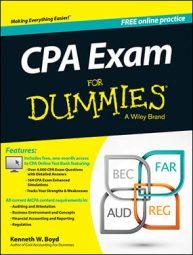The Regulation (REG) test on the CPA exam asks about the different types of corporate structures someone can select when forming a business. Each structure has different rules about owner liability and its own method of taxation.
Partnership structures
A partnership is defined as two or more people who enter into a business by creating a partnership agreement. A partnership is a separate legal entity, an entity that files its own tax return. The REG test refers to the revised uniform partnership act, which governs partnerships.
This agreement documents how the partners allocate profits and losses and how a partner’s capital account balance is calculated. Partner capital is comparable to the equity section of the balance sheet for a corporation. Both capital and equity refer to ownership in the entity.
Partners also have the right to participate in the partnership by voting on issues. Partners have a right to make decisions on important issues, just as stockholders have rights as owners of corporations.
A partnership is a pass-through entity, an entity in which the profit and loss flow through to the owners. The partnership entity files a tax return, but the profit and loss on the partnership flows through to the personal tax returns of the partners.
Each partnership has at least one general partner. The general partners are responsible for the day-to-day management of the partnership. A general partner may manage the partnership himself or hire a manager.
A frequently tested area on the REG test concerns partnership liability. General partners have unlimited liability for the acts of the partnership. This includes other partners’ actions on behalf of the partnership.
Unlimited liability means that the general partner’s personal assets are at risk, as is that partner’s investment in the partnership. A limited partner’s liability is limited to that partner’s investment in the partnership.
Suppose a partnership owns a restaurant. Patrick is a general partner who manages the restaurant. Greg is a limited partner. After slipping and falling outside the restaurant, a customer sues the partners to recover the medical costs of his injuries. Patrick, the general partner, has unlimited liability for the litigation. The limited partner, Greg, has his liability limited to his partnership investment.
Ownership of a partnership is in partner capital accounts. Each partner has an individual capital account. The sum of all the capital accounts represents the entire capital of the partnership. Here are the transactions that increase and decrease capital accounts:
Partner capital increases: Capital accounts are increased by capital contributions by the partners. When a partner contributes cash or other assets (like a vehicle or equipment), her capital account is increased. Her capital account is also increased by her share of the partnership profit. Each partner’s share of profits and losses is documented in the partnership agreement.
Partner capital decreases: A partner’s taking assets out of the partnership is a withdrawal. The partner’s capital is reduced by her share of partnership losses.
The partner’s interest in the profit of a partnership can be assigned to someone else. If, for example, a partner wanted a child to receive income generated by the partnership, the partner can assign that interest. Ownership in a partnership, however, cannot be assigned. The rationale is that Partner A entered into a partnership with Partner B, so Partner A shouldn’t be forced into a partnership with someone besides A.
Corporate structures
A corporation is a group of people authorized to act as a single entity. The corporation, in fact, is considered a person from a legal point of view. The owners of a company are shareholders, who invest assets in a company in exchange for common stock.
The equity section of a corporation consists of common stock, additional paid-in capital, and retained earnings. Consider the transactions that would increase and decrease stockholders’ equity:
Increase in stockholders’ equity: Issuing shares of stock to the public for the first time is an initial public offering. Investors pay cash (or contribute other assets) in exchange for stock. A public offering increases equity. Note that when stock is sold between investors, no additional funds come into the business.
Companies raise funds when stock is purchased directly from the corporation. If a company generates earnings and keeps those earnings in the business, those retained earnings increase equity.
Decrease in stockholders’ equity: Treasury stock refers to stock repurchased by the corporation from shareholders. When the corporation buys back the stock, equity is decreased. When a company has earnings and pays a portion of the earnings to shareholders, the payment is a dividend. Dividends also reduce earnings.
The REG test focuses on the pros and cons of forming a corporation as a business structure.

